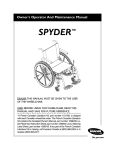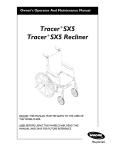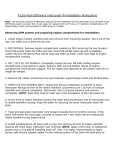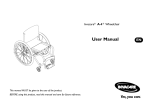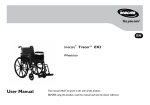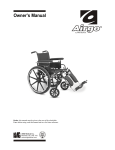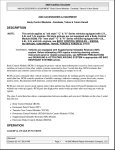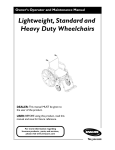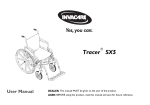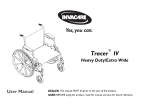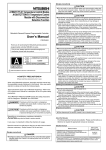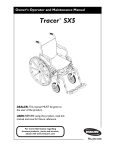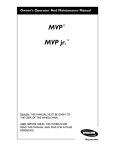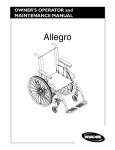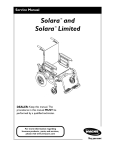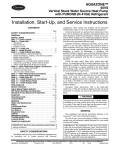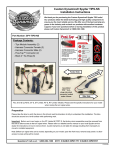Download Service Manual
Transcript
Service Manual 52;,-4c DEALER: KEEP THIS MANUAL. THE PROCEDURES IN THIS MANUAL MUST BE PERFORMED BY A QUALIFIED TECHNICIAN ONLY. WARNING WARNING W A R N I N G DO NOT SERVICE, REPAIR OR OPERATE THIS EQUIPMENT WITHOUT FIRST READING AND UNDERSTANDING THIS MANUAL AND THE SPYDER OWNER'S MANUAL, PART NUMBER 1093830. IF YOU ARE UNABLE TO UNDERSTAND THE WARNINGS, CAUTIONS, AND INSTRUCTIONS, CONTACT A HEALTHCARE PROFESSIONAL, DEALER OR TECHNICAL PERSONNEL IF APPLICABLE BEFORE ATTEMPTING TO USE THIS EQUIPMENT - OTHERWISE INJURY OR DAMAGE MAY RESULT. THE INITIAL SET UP OF THIS WHEELCHAIR MUST BE PERFORMED BY A QUALIFIED TECHNICIAN. PROCEDURES DESCRIBED IN THIS MANUAL MUST BE PERFORMED BY A QUALIFIED TECHNICIAN. SAVE THESE INSTRUCTIONS SPECIAL NOTES S P E C I A L N O T E S WARNING/CAUTION notices as used in this manual apply to hazards or unsafe practices which could result in personal injury or property damage. NOTICE THE INFORMATION CONTAINED IN THIS DOCUMENT IS SUBJECT TO CHANGE WITHOUT NOTICE. WHEELCHAIR USER As a manufacturer of wheelchairs, Invacare endeavors to supply a wide variety of wheelchairs to meet many needs of the end user. However, final selection of the type of wheelchair to be used by an individual rests solely with the user and his/her healthcare professional capable of making such a selection. WHEELCHAIR TIE-DOWN RESTRAINTS AND SEAT POSITIONING STRAPS Invacare recommends that wheelchair users NOT be transported in vehicles of any kind while in wheelchairs. As of this date, the Department of Transportation has not approved any tie-down systems for transportation of a user while in a wheelchair, in a moving vehicle of any type. It is Invacare’s position that users of wheelchairs should be transferred into appropriate seating in vehicles for transportation and use be made of the restraints made available by the auto industry. Invacare cannot and does not recommend any wheelchair transportation systems. AS REGARDS RESTRAINTS - SEAT POSITIONING STRAPS - IT IS THE OBLIGATION OF THE DME DEALER, THERAPISTS AND OTHER HEALTHCARE PROFESSIONALS TO DETERMINE IF A SEATING POSITIONING STRAP IS REQUIRED TO ENSURE THE SAFE OPERATION OF THIS EQUIPMENT BY THE USER. SERIOUS INJURY CAN OCCUR IN THE EVENT OF A FALL FROM A WHEELCHAIR. 2 TABLE OF CONTENTS TABLE OF CONTENTS SPECIAL NOTES ..................................................................................................................................... 2 LABELS ................................................................................................................................................... 4 SPECIFICATIONS .................................................................................................................................... 5 PROCEDURE 1 - GENERAL GUIDELINES ............................................................................................. 6 STABILITY ................................................................................................................................................ 6 TIRE PRESSURE .................................................................................................................................... 7 WEIGHT LIMITATION ................................................................................................................................ 7 PROCEDURE 2 - SAFETY INSPECTION ................................................................................................ 8 SAFETY INSPECTION CHECKLIST .......................................................................................................... 8 TROUBLESHOOTING ............................................................................................................................. 9 MAINTENANCE/TRANSPORTING ............................................................................................................. 9 PROCEDURE 3 - FRAME ...................................................................................................................... 10 ADJUSTING THE BACK ANGLE .............................................................................................................. 10 ADJUSTING THE REAR SEAT DUMP ..................................................................................................... 10 ADJUSTING THE SEAT WIDTH ...............................................................................................................11 REPLACING THE FOLDING MECHANISM ................................................................................................11 REMOVING/INSTALLING/ADJUSTING BACK RELEASE CORD ................................................................ 12 REPLACING OPTIONAL BACK UPHOLSTERY ....................................................................................... 14 ADJUSTABLE TENSION BACK UPHOLSTERY ....................................................................................... 15 PROCEDURE 4 - ARMS ........................................................................................................................ 16 INSTALLING T-ARM SOCKETS ............................................................................................................... 16 REPLACING THE T-ARM LOCKING LEVER ............................................................................................ 16 PROCEDURE 5 - CASTERS ................................................................................................................. 17 REPLACING/REPOSITIONING/INSTALLING FRONT CASTERS ............................................................... 17 INSTALLING/REPLACING FORKS........................................................................................................... 17 ADJUSTING CASTER HEADTUBES ....................................................................................................... 18 PROCEDURE 6 - REAR WHEELS ......................................................................................................... 19 ADJUSTING WHEELBASE WIDTH ......................................................................................................... 19 ADJUSTING REAR WHEEL CAMBER ..................................................................................................... 19 ADJUSTING REAR WHEEL HEIGHT ....................................................................................................... 20 ADJUSTING WHEELBASE LENGTH ....................................................................................................... 20 HANDRIMS ............................................................................................................................................ 21 PROCEDURE 7 - STABILITY ADJUSTMENTS ..................................................................................... 23 SEAT-TO-FLOOR HEIGHT DETERMINATION ......................................................................................... 23 CHANGING SEAT-TO-FLOOR HEIGHT ................................................................................................... 23 INSTALLING/ADJUSTING ANTI-TIPPER MOUNTING BRACKETS .............................................................. 31 INSTALLING/ADJUSTING THE ANTI-TIPPERS ......................................................................................... 32 PROCEDURE 8 - SUSPENSION ........................................................................................................... 34 ELASTOMERS AND SUSPENSION ........................................................................................................ 34 REPLACING FRONT ELASTOMERS ...................................................................................................... 34 3 T A B L E C O N T E N O T F S LABELS WARNING LABEL LOCATIONS WARNING L A B E L S WARNING Pinch point. To unfold, grasp top edge ONLY. 1097049 Rev. ARev. (1)A (1)-3/00 3/00 P/N 1097049 DO NOT step or stand on rear folding links. 1097061 Otherwise, injury or damage may occur.Rev.A (1)3/00 WARNING DO NOT OPERATE WITHOUT THE ANTI-TIP TUBES INSTALLED. REV. 5/98 WARNING Detent balls should extend beyond the diameter of the axle bushing for a positive lock. Keep detent balls clean. REV.10/98 1026960 4 P/N 60106X144 SPECIFICATIONS SPECIFICATIONS SPYDER SPECIFICATIONS Seat Width: Seat Depth: Seat-to-Floor: 14 to 20-inches 14 to 18-inches REAR Seat-to-Floor Range 20-inch rear wheels 22-inch rear wheels 24-inch rear wheels and 559 rear wheels 26-inch rear wheels - 14-1/4 to 18-1/4-inches 14-1/2 to 19-inches 15-1/2 to 20-inches 16-1/2 to 20-inches FRONT Seat-to-Floor Range 3-inch Front Casters 5-inch Front Casters 6-inch Front Casters 8-inch Front Casters - 16-3/4 to 17-1/4-inches 17 to 19-inches 18 to 19-1/2-inches 20-inches o Back Height: Push Handles - 10 bend Sportster - No Push Handles Straight with Push Handles - Footrest: 60 , 70 , 90 - Swingaway, Tapered, Non-Tapered, Elevating Legrest, Adjustable Angle Flip-up Footplates, Composite Footplates Rear Axle: Quick-Release, Quad-Release Rear Wheels: 20, 22, 24-inch Composite Wheels 22, 24, 26-inch Spoke Wheels 24, 26-inch Hi-Performance Spoke Wheels 559 High Performance/Turbo Tire OPTIONAL - 24, 26-inch Continental Tires, 22, 26-inch Pneumatic Tires, Flat Free Inserts Handrims: Aluminum Anodized, Plastic Coated, Black Plastic Coated, Vertical/Oblique Projection Plastic Coated, Spoke Guards Wheel Locks: High Mount Pull to Lock (Standard), Wheel Lock Extensions, Hill Holder, Undermount Wheel Lock Caster Size: 3, 5, 6 and 8-inch (Urethane or Pneumatic), Precision Sealed Bearings Flat Free Inserts Seat Cushion: 2 or 3-inch (Optional) Back Upholstery: Black Nylon (Optional), Adjustable Back Upholstery (Standard) Weight: 29.6 lbs. - with Rear Wheels 20.4 lbs. - without Rear Wheels 44 lbs. Shipping Weight (approx.)*: o o 16-18-inches and 20-inches 12-14-inches 12-18-inches o *14-inch Seat Frame with complete package. 5 S P E C I F I C A T I O N S PROCEDURE 1 This Procedure Includes the Following: Stability Operating Information Tire Pressure Weight Training Weight Limitation STABILITY STABILITY WARNINGS Seat Dump Back Angle Seating System Caster Size Caster Position Rear Wheel Size Rear Wheel Position User Condition ● ✓ User Condition Anti-Tippers Rear Wheel Position Rear Wheel Size ✓ ✓ ● ✓ ✓ ✓ ● ✓ ● ✓ Caster Position Caster Size Seating System Back Angle The seat dump, back angle, seating system, caster size and position, rear wheel size and position, anti-tippers, as well as the user condition directly relate to the stability of the wheelchair. Any change to one (1) or any combination of the nine (9) may cause the wheelchair to decrease in stability. These adjustments MUST be performed by a qualified technician ONLY. Seat Dump G E N E R A L G U I D E L I N E S GENERAL GUIDELINES ✓ ✓ ✓ ✓ ✓ ✓ ✓ ● ✓ ✓ ✓ ✓ ✓ ✓ ● ✓ ✓ ✓ ✓ ✓ ✓ ● ✓ ✓ ✓ ✓ ✓ ✓ ✓ ● NOTE: When changes to the left hand column occur, follow across the chart and refer to the ✓ procedure to maintain the proper stability, safety and handling of the wheelchair. NOTE: Additional adjustments may be needed according to the wheelchair type. Refer to the wheelchair owner's manual for these procedures. To maintain maximum stability, position the rear wheels in the most rearward position on the wheelchair frame. Moving the rear wheels forward WILL cause the wheelchair to decrease in stability. ALWAYS ensure stability BEFORE moving the rear wheels forward. TEST wheelchair BEFORE it is occupied by the end user to ensure safety. Seat-to-floor heights depend on specific rear wheel size, rear wheel position, and front caster size and position. These adjustments MUST be performed by a qualified technician. ANTI-TIPPERS Anti-tippers are specific to the seat-to-floor height of the wheelchair. Refer to the chart in PROCEDURE 7 of this manual for correct usage and adjustment. If these requirements cannot be achieved, DO NOT use the wheelchair. Contact Invacare technical support at 1-800-832-4707. Any changes to the seat-to-floor height may require different anti-tippers. Seat-to-floor height: If changing seat-to-floor height, the correct anti-tippers MUST be installed to maintain a 1-1/2 to 2-inch ground clearance. Refer to PROCEDURE 7 of this manual. 6 GENERAL GUIDELINES PROCEDURE 1 GENERAL WARNINGS Refer to PROCEDURE 1 - GENERAL GUIDELINES in the Spyder owner's manual for additional operating information. Unless otherwise noted, all service and adjustments should be performed while the wheelchair is unoccupied. To determine and establish the user's particular safety limits, bending, reaching and transferring activities in several combinations should be practiced in the presence of a qualified healthcare professional BEFORE attempting active use of the wheelchair. DO NOT use parts, accessories, or adapters other than those authorized by Invacare. DO NOT attempt to lift a wheelchair by lifting on any removable (detachable) parts. Lifting by means of any removable (detachable) parts of a wheelchair may result in injury to the user or damage to the wheelchair. Anti-tippers MUST BE attached at all times. Inasmuch as the ANTI-TIPPERS are an option on this wheelchair (You may order with or without the anti-tippers), Invacare strongly recommends ordering the anti-tippers as an additional safeguard for the wheelchair user. ALWAYS wear seat positioning strap. Inasmuch as the SEAT POSITIONING STRAP is an option on this wheelchair (You may order with or without the seat positioning strap), Invacare strongly recommends ordering the seat positioning strap as an additional safeguard for the wheelchair user. TIRE PRESSURE DO NOT use wheelchair unless it has the proper tire pressure (p.s.i.). DO NOT overinflate the tires. Failure to follow these suggestions may cause the tire to explode and cause bodily harm. Replacement of a pneumatic tire or tube MUST be performed by a qualified technician. WEIGHT LIMITATION The Invacare Spyder has a weight limitation of 250 lbs. (113.5 kg.). 7 G E N E R A L G U I D E L I N E S PROCEDURE 2 S A F E T Y I N S P E C T I O N SAFETY INSPECTION NOTE: Every six (6) months the wheelchair should be serviced and thoroughly inspected by a qualified technician. Regular cleaning will reveal loose or worn parts and enhance the smooth operation of your wheelchair. To operate properly and safely, your wheelchair must be cared for just like any other vehicle. Routine maintenance will extend the life and efficiency of your wheelchair. This Procedure includes the following: Safety Inspection Checklist Troubleshooting Maintenance/Transporting SAFETY INSPECTION CHECKLIST Initial adjustments should be made to suit your personal body structure and preference. Thereafter follow these maintenance procedures: ITEM INITIALLY INSPECT/ ADJUST WEEKLY GENERAL - TROUBLESHOOTING Wheelchair rolls straight (no excessive drag or pull to one side). Inspect folding front strap for wear and damage. X X SEAT AND BACK UPHOLSTERY - PROCEDURE 3 Inspect for rips or excessive sagging. Inspect fastening flaps to ensure they securely latch. Inspect back release cord for wear. X X X WHEEL LOCKS Do not interfere with tires when rolling. Pivot points free of wear and looseness. Wheel locks easy to engage. X X X REAR WHEELS Axle plate is securely tightened. Quick/Quad-release axles lock properly. No excessive side movement or binding when lifted /spun. X X X HANDRIMS - PROCEDURE 6 Inspect for signs of rough edges or peeling finish. X SPOKES Inspect for bent or broken spokes. All spokes uniformly tight. X X X X X X FRONT CASTERS - PROCEDURE 5 Inspect wheel/fork assembly for proper tension by spinning caster; caster should come to a gradual stop. Loosen/tighten locknut if wheel wobbles noticeably or binds to a stop. Wheel bearings are clean and free of moisture. CAUTION: As with any vehicle, the wheels and tires should be checked periodically for cracks and wear, and should be replaced. X X CLEANING Clean upholstery and armrests. Inspect axles are free from dirt, lint, and debris. INSPECT/ ADJUST PERIODICALLY X X X X X X X X X X X X X X X TIRES Inspect for flat spots and wear. If pneumatic tires check for proper inflation. CAUTION: As with any vehicle, the wheels and tires should be checked periodically for cracks and wear, and should be replaced. INSPECT/ ADJUST MONTHLY X X X X X X X X NOTE: Refer to the Spyder Owner's Manual, part number 1093830 for adjustment procedures not in this manual. 8 SAFETY INSPECTION PROCEDURE 2 TROUBLESHOOTING CHAIR VEERS RIGHT CHAIR VEERS LEFT SLUGGISH TURN OR PERFORMANCE CASTER FLUTTERS X X X X X X X X X SQUEAKS AND RATTLES X LOOSENESS IN CHAIR CHAIR 3 WHEELS X SOLUTIONS Check tires for correct and equal pressure. X X Check for loose stem nuts. X X Check spokes/nipples. X MAINTENANCE/TRANSPORTING X Check caster headtube angle. X Check that rear wheels are equally spaced away from seat frame (Procedure 6). CAUTION As with any vehicle, the wheels and tires should be checked periodically for cracks and wear, and should be replaced. Maintenance Safety Precautions WARNING After ANY adjustments, repair or service and BEFORE use, make sure all attachment hardware is tightened securely - otherwise, injury or damage may result. 5. Check wheels and tires periodically for cracks and wear. If damaged, have them replaced by a qualified technician. CAUTION 7. Periodically check handrims to ensure they are secured to the rear wheels. If loose or damaged, have them tightened or replaced by a qualified technician. 6. Regularly check for loose spokes in the rear wheels. If loose, have them adjusted by a qualified technician. DO NOT overtighten hardware attaching to the frame. This could cause damage to the frame tubing. Suggested Maintenance Procedures 8. Periodically adjust wheel locks in correlation to tire wear. Refer to REPLACING/ADJUSTING THE WHEEL LOCK in the Spyder owner's manual, part number 1093830. 1. Before using your Invacare SPYDER, make sure all nuts and bolts are tight. Check all parts for damage or wear and replace. Check all parts for proper adjustment. 9. Periodically check caster wheel bearings to make sure ® they are clean and free from moisture. Use a Teflon lubricant if necessary. 2. Keep quick/quad-release axles free of dirt and lint to ensure positive locking and proper operation. Refer to ADJUSTING QUICK-RELEASE AXLES or ADJUSTING QUAD-RELEASE AXLES in the Spyder owner's manual, part number 1093830. 10. Check upholstery for sagging, rips or tears. 3. Oil quick-release axles at least once (1) a month (3® in-1 oil or equivalent). NOTE: Refer to the Spyder owner's manual, part number 1093830 for the procedures mentioned below. Transporting the Invacare Spyder 1. Remove the seating system. Refer to seating system owner's manual. 2. Remove the footrests. WARNING 3. Remove the arms. DO NOT use the wheelchair unless it has the proper tire pressure (p.s.i.). DO NOT overinflate the tires. Failure to follow these suggestions may cause the tire to explode and cause bodily harm. 4. Fold down the back. 5. Fold the wheelchair. 6. Remove the rear wheels. 7. After transporting, reverse STEPS 1-6 to prepare the wheelchair for use. 4. Recommended tire pressure is listed on the sidewall of the tire. 3-in-1 oil - Registered trademark of American Home Products Corporation. Teflon - Registered trademark of E. I. Du Pont De Nemours and Company. 9 S A F E T Y I N S P E C T I O N PROCEDURE 3 F R A M E FRAME ADJUSTING THE REAR SEAT DUMP (FIGURE 2) This Procedure includes the following: Adjusting the Back Angle Adjusting the Rear Seat Dump Adjusting the Seat Width Replacing the Folding Mechanism Removing/Installing/Adjusting Back Release Cord Replacing Optional Back Upholstery Adjustable Tension Back Upholstery Seat dump is a measurement taken at the rear of the seat from the horizontal position, and is measured in inches. Refer to DETAIL “A” of FIGURE 2. The seat dump of the Spyder can be adjusted in1/2-inch increments, up to 2-1/2inches below the front seat-to-floor height. NOTE: Adjust both rear uprights to the same position. 1. Remove the bolt and locknut securing the rear upright to the wheelchair frame. WARNING 2. Loosen, but do not remove the front and rear pivot bolt. After ANY adjustments, repair or service and BEFORE use, make sure all attachment hardware is tightened securely - otherwise, injury or damage may result. NOTE: Loosening the pivot nut allows the back angle to remain the same in relation to the ground. No adjustment is necessary to the back angle when adjusting seat dump. 3. Reposition the rear upright up or down and align the mounting holes in the rear upright with the mounting holes in the frame until the desired seat dump is achieved. Refer to the chart below. ADJUSTING THE BACK ANGLE (FIGURE 1) WARNING SEAT DUMP REAR UPRIGHT (INCHES) HOLE BEFORE performing this procedure, refer to STABILITY in PROCEDURE 1 of this manual for additional requirements. 0 1/2 1 1-1/2 2 2-1/2 1. Fold the back. Refer to FOLDING/UNFOLDING THE BACK in PROCEDURE 5 of the Spyder owner's manual, part number 1093830. 2. Remove the locknut and bolt at the top of the angle bracket. 3. Reposition the bolt through one (1) of the four (4) mounting positions in the angle bracket as shown in FIGURE 1. 4. Install the locknut. Tighten securely. FRAME HOLE C B A B A B 1 1 1 2 2 3 4. Install the hex bolt and locknut in the mounting hole determined in STEP 3 to secure the rear upright to the wheelchair frame. 5. Tighten the front and rear pivot bolt. 5. Repeat STEPS 2-4 for the opposite back cane. 6. Unfold the back. Refer to FOLDING/UNFOLDING THE BACK in PROCEDURE 5 of the Spyder owner's manual, part number 1093830. NOTE: Back angles are relative to the ground, NOT the seat. BACK ANGLE POSITIONS Back Cane 85° 90° 95° Mounting Positions Bolt Locknut Angle Bracket FIGURE 1 - ADJUSTING THE BACK ANGLE 10 100° FRAME PROCEDURE 3 REPLACING THE FOLDING MECHANISM (FIGURE 3) DETAIL “A” - REAR SEAT DUMP MEASURED IN INCHES Seat Rail WARNING Rear Pivot Bolt NEW retaining rings MUST be used when replacing the Spyder folding mechanism. Existing retaining rings may become bent during removal and may not properly secure the folding mechanism. S E AT DUMP Front Pivot Bolt Invacare strongly recommends using a retaining ring insertion tool to install retaining rings. If not properly installed, the retaining rings may become bent or damaged and injury may occur. 2-1/2 2 1-1/2 1 1/2 CAUTION INSTALLED REMOVED Hole A Hole B Hole C Hole 1 Rear Upright Pivot Nut Locknut (NOT SHOWN) Hole 2 Bolt Hole 3 Wheelchair Frame FIGURE 2 - ADJUSTING THE REAR SEAT DUMP ADJUSTING THE SEAT WIDTH The following items MUST be replaced to adjust the seat width: 1. Folding Mechanism. Refer to REPLACING THE FOLDING MECHANISM in this procedure of the manual. 2. Seat Upholstery. Refer to REPLACING SEAT UPHOLSTERY in PROCEDURE 4 of the Spyder owner's manual, part number 1093830. 3. Back Upholstery. Refer to REPLACING OPTIONAL BACK UPHOLSTERY or ADJUSTABLE BACK UPHOLSTERY in this procedure of the manual. DO NOT use excessive force when removing or installing bushings. Otherwise, the bushings may become deformed. NOTE: The folding mechanism consists of ALL the folding links assembled to the center track. 1. Using a flat screwdriver, remove EXISTING retaining rings securing bushings to the wheelchair frame. 2. Fold the wheelchair to remove tension on the bushings. Refer to FOLDING/UNFOLDING THE WHEELCHAIR in the Spyder owner's manual, part number 1093830. 3. Remove EXISTING bushings from wheelchair frame with a punch or phillips screwdriver and a rubber mallet. 4. Remove EXISTING folding mechanism from the wheelchair. 5. Align the folding links of the NEW folding mechanism with the mounting holes on the wheelchair frame. 6. Insert the outer bushings UP through the following items in the order listed: A. LOWER mounting hole B. LOWER folding link C. CENTER folding link (REAR ONLY) OR spacer (FRONT ONLY) D. UPPER folding link E. UPPER mounting hole NOTE: Rear outer bushings should be inserted with the frame protectors facing down. NOTE: The lower notch on the rear outer bushing is above the frame protector. NOTE: Ensure the notches on the outer bushings are above and below the wheelchair frame on either end. 7. Install one (1) new retaining ring onto each outer bushing notch using a retaining ring insertion tool. NOTE: Ensure all three (3) tabs on each retaining ring are completely inserted into the notch as shown in DETAIL "A" of FIGURE 3. 11 F R A M E PROCEDURE 3 FRAME REMOVING/INSTALLING/ADJUSTING BACK RELEASE CORD (FIGURE 4) FRONT VIEW OF WHEELCHAIR Upper Mounting Hole (NOT SHOWN) Retaining Ring F R A M E Upper Folding Link WARNING After adjusting or replacing back release cord, ensure back is locked securely in place BEFORE using the wheelchair. Spacer Lower Folding Link Removing Back Release Cord 1. Remove back cushion/system from wheelchair, if necessary. Refer to back system owners manual for removal procedures. 2. Untie the knots securing the ends of the back release cord to the back release latches. Lower Mounting Hole (NOT SHOWN) Notches 3. Remove back release cord from back release latches. 4. Perform one (1) of the following: A. BACK UPHOLSTERY - Remove the back release cord from the back upholstery. FRONT Outer Bushing Retaining Ring B. BACK SYSTEM - Remove the back release cord from the eyelets on each back cane. REAR VIEW OF WHEELCHAIR Retaining Ring Upper Mounting Hole (NOT SHOWN) Upper Folding Link 5. Press the star wheel DOWN to open the cord lock. 6. Remove the back release cord from the cord lock. 7. Perform one (1) of the following: A. BACK UPHOLSTERY - Refer to INSTALLING BACK RELEASE CORD WITH BACK UPHOLSTERY in this procedure of the manual. Center Folding Link Lower Folding Link Lower Mounting Hole (NOT SHOWN) Notches REAR Outer Bushing Retaining Ring Frame Protector B. BACK SYSTEM - Refer to INSTALLING BACK RELEASE CORD WITH BACK SYSTEM in this procedure of the manual. Installing Back Release Cord with Back Upholstery 1. Press the star wheel down to open the cord lock. 2. Thread one (1) end of back release cord through cord lock. NOTE: Ensure there are equal portions of back release cord on either side of the cord lock. 3. Press the star wheel UP to lock the cord lock. 4. Thread one (1) end of the back release cord through a grommet in the back upholstery as shown in FIGURE 4. DETAIL "A" - RETAINING RINGS Three (3) Tabs Retaining Ring Bushing FIGURE 3 - REPLACING THE FOLDING MECHANISM 12 FRAME PROCEDURE 3 5. Perform the following steps to secure the back release cord to the back release latch (DETAIL "B"): A. Thread the end of the back release cord from STEP 4 through back release latch from the inside of the wheelchair to the outside of the wheelchair. B. Knot the end of the back release cord. C. Pull knot up and over back release cord to make a loop. D. Push knot down and through back release cord loop. E. Grasp and hold knot end of back release cord. F. Pull the back release cord on the outside of the upholstery to tighten the knot. 6. Repeat STEPS 4-5 for opposite end of back release cord. 7. Trim excess back release cord from knot to 1/4-inch. 8. Burn end of excess back release cord to prevent fraying. 9. Adjust back release cord to desired tightness. Refer to ADJUSTING BACK RELEASE CORD in this procedure of the manual. 10. Reinstall back cushion, if necessary. Installing Back Release Cord with Back System 1. Press the star wheel DOWN to ensure cord lock is open. 2. Thread one (1) end of back release cord through the cord lock. NOTE: Ensure there are equal portions of back release cord on either side of the cord lock. 3. Press the star wheel UP to lock the cord lock. 4. Examine one (1) back cane to determine whether eyelets are installed. 5. Perform one (1) of the following: A. EYELETS ARE INSTALLED - Proceed to STEP 9. B. EYELETS ARE NOT INSTALLED - Proceed to STEP 6. 6. Remove the lower back cane nut. NOTE: DO NOT remove the lower back cane bolt. 7. Position the eyelet onto the lower back cane bolt as shown in FIGURE 4. NOTE: Eyelet should bend towards the inside of the wheelchair frame. 8. Install lower back cane nut onto lower back cane bolt. 9. Thread one (1) end of the back release cord through an eyelet on the back cane as shown in FIGURE 4. 10. Perform the following steps to secure the back release cord to the back release latch (DETAIL "B"): A. Thread the end of the back release cord from STEP 9 through back release latch from the inside of the wheelchair to the outside of the wheelchair. B. Knot the end of the back release cord. C. Pull knot up and over back release cord to make a loop. D. Push knot down and through back release cord loop. E. Grasp and hold knot end of back release cord. F. Pull the back release cord to tighten the knot. 11. Repeat STEPS 4-10 for the other end of the back release cord. 12. Trim excess back release cord from knot to 1/4-inch. 13. Burn end of excess back release cord to prevent fraying. 14. Adjust back release cord to desired tightness. Refer to ADJUSTING BACK RELEASE CORD in this procedure of the manual. 15. Install back system onto back canes. Refer to back system owner's manual for installation procedures. Adjusting Back Release Cord NOTE: The back release cord may be adjusted to a tight or loose fit to meet the need of the user. 1. Press the star wheel DOWN to open the cord lock. 2. Adjust the back release cord to the desired tension. 3. Press the star wheel UP to lock the cord lock. 13 F R A M E PROCEDURE 3 FRAME DETAIL "A" - CORD LOCK Star Wheel F R A M E REPLACING OPTIONAL BACK UPHOLSTERY (FIGURE 5) Cord Lock 1. Remove back release cord. Refer to REMOVING/ INSTALLING/ADJUSTING BACK RELEASE CORD in this procedure of the manual. Back Release Cord 2. Remove the two (2) phillips screws and washers that secure the existing back upholstery to the back canes. NOTE: It may be necessary to pull the back upholstery up to reveal the back height adjustment screw securing the back cane to the wheelchair frame. DETAIL "B" - BACK RELEASE LATCH OUTSIDE INSIDE OF OF WHEELCHAIR WHEELCHAIR Back Release Cord 3. Remove the back height adjustment screw and locknut that secure one (1) back cane to the wheelchair frame. NOTE: It is necessary to remove only one (1) back cane to replace the back upholstery. STEPS A-B Back Release Latch 4. Pull loose back cane out of EXISTING back upholstery. Knot 5. Pull the EXISTING back upholstery up and over the mounted back cane. Knot 6. Install the NEW back upholstery over mounted back cane. STEP C Back Release Cord Loop 7. Slide loose back cane through NEW back upholstery. 8. Using the mounted back cane as a guide, reinstall the loose back cane to the wheelchair frame with the existing back height adjustment screw and locknut. Knot STEPS D-F Back Release Cord Loop NOTE: For proper installation of the back upholstery, the back canes MUST be mounted in the same height adjustment hole. Excess 9. Secure the new back upholstery to the back canes with the two (2) phillips screws and washers. Torque to 20-25 in./lbs. SEATING SYSTEM RIGHT Back Cane Lower Back Cane Nut INSIDE OF WHEELCHAIR OUTSIDE OF WHEELCHAIR 10. Install back release cord. Refer to REMOVING/INSTALLING/ADJUSTING BACK RELEASE CORD in this procedure of the manual. Back Upholstery Washer Lower Back Bent Portion of Eyelet Cane Bolt NOTE: Left back cane not shown for clarity. Back Cane BACK UPHOLSTERY Phillips Screw Grommets Phillips Screw Back Release Cord Back Upholstery Washer Back Height Adjustment Screw Tie Wrap Mounting Hole FIGURE 5 - REPLACING OPTIONAL BACK UPHOLSTERY FIGURE 4 - REMOVING/INSTALLING/ ADJUSTING THE BACK RELEASE CORD 14 FRAME PROCEDURE 3 ADJUSTABLE TENSION BACK UPHOLSTERY (FIGURE 6) 5. Slip adjuster straps through corresponding anchor loops and adjust the back upholstery. Secure with the fastening straps. The Adjustable Tension Straps 6. Install back release cord. Refer to REMOVING/INSTALLING/ADJUSTING BACK RELEASE CORD in this procedure of the manual. The straps can be adjusted at various levels of tension to accommodate individual end-users. The bottom two (2) straps can be adjusted tightly to support and/or assist the extensor muscles. The Back Upholstery Cover The back upholstery cover is designed for three (3) reasons: 1. The first is as a modesty cover. 2. The second is to keep the cushion from sliding out of the back of the wheelchair. 3. The third is a sacral support depending upon how far or tight the flap is pulled under the seat cushion. Installing Adjustable Tension Back Upholstery 1. Remove the existing back upholstery from the wheelchair. Refer to STEPS 1-5 in REPLACING OPTIONAL BACK UPHOLSTERY in this procedure of the manual. 7. Secure the back upholstery cover (fastening strap) to the back of the adjustable back upholstery (fastening strap). 8. Flip the back upholstery cover over the adjustable back upholstery and secure the fastening straps to the front of the adjustable back upholstery. 9. Lay the front portion of the back upholstery cover on the seat upholstery. 10. Adjust the slack in the back upholstery cover and then secure to the seat upholstery. Removing Adjustable Tension Back Upholstery 1. Remove the back upholstery cover from the seat and back upholstery. 2. Remove the back release cord. Refer to REMOVING/INSTALLING/ADJUSTING BACK RELEASE CORD in this procedure of the manual. 2. Using the mounted back cane as a guide, reinstall the loose back cane to the wheelchair frame with the existing allen screw and locknut. 3. Remove mounting screws from upper grommet holes in back upholstery. NOTE: The back canes must be mounted in the same height adjustment hole. 4. Slide anchor loop section and adjuster strap section of back upholstery off back canes. 3. Stand behind the wheelchair and perform the following: Fastening Strap A. Slide anchor loop section of adjustable tension back upholstery over the LEFT back cane with the upper grommet hole facing the rear of the wheelchair. Back Upholstery Cover Fastening Straps B. Slide adjuster strap section of adjustable tension back upholstery over the RIGHT back cane with the upper grommet hole facing the rear of the wheelchair. 4. Secure adjustable tension back upholstery to back canes with the mounting screws. Torque to 20-25 in./lbs. Adjuster Strap Anchor Loop NOTE: Clean the upholstery with warm water and mild detergent to remove superficial soil. WARNING After the adjustable tension back upholstery has been positioned to the end-users individual needs, the fastening straps MUST be securely fastened BEFORE applying the back upholstery cover. The adjustable back should be checked whenever entering the wheelchair to ensure that the fastening straps are securely fastened. Back Upholstery Anchor Loop Section Back Cane Upper Grommet Hole Mounting Screw Back Upholstery Adjuster Strap Section FIGURE 6 - ADJUSTABLE TENSION BACK UPHOLSTERY 15 F R A M E PROCEDURE 4 ARMS REPLACING THE T-ARM LOCKING LEVER (FIGURE 2) This Procedure includes the following: Installing T-Arm Sockets Replacing the T-Arm Locking Lever 1. Remove T-arm from wheelchair. Refer to INSTALLING/REMOVING T-ARMS in the Spyder owners manual, part number 1093830. 2. Remove the phillips bolt and locknut that secure the existing locking lever to the bottom bracket. WARNING A R M S After ANY adjustments, repair or service and BEFORE use, make sure all attachment hardware is tightened securely - otherwise, injury or damage may result. CAUTION The locking lever is spring loaded. Place your free hand over the locking lever to prevent the parts from springing off of the bottom bracket. INSTALLING T-ARM SOCKETS (FIGURE 1) 1. Remove rear wheels from wheelchair, if necessary, Refer to INSTALLING/REMOVING REAR WHEELS in the Spyder owner's manual, part number 1093830. 2. Position the T-arm clamp on the wheelchair frame as shown in FIGURE 1. NOTE: T-arm socket must be positioned on outside of wheelchair frame. 3. Install hex bolts through T-arm clamp, wheelchair frame and coved washers and tighten securely with locknuts. 4. Position the T-arm socket inserts in the T-arm socket as shown in FIGURE 1. 5. Line up the mounting holes in the T-arm socket with the threaded holes in the T-arm clamp. 6. While holding the T-arm socket and the T-arm clamp together, install the four (4) hex screws and washers into mounting holes and tighten loosely. 7. Adjust the T-arm socket. Refer to ADJUSTING THE T-ARMS in the Spyder owner's manual, part number 1093830. 8. Repeat STEPS 2-7 for opposite side of wheelchair. 9. Install the T-arm into the T-arm sockets. Refer to INSTALLING/REMOVING T-ARMS in the Spyder owner's manual, part number 1093830. Locknut Wheelchair Frame 3. Remove existing locking lever and spring from bottom bracket. NOTE: Inspect the spring and replace if necessary. 4. Position spring on bottom bracket as shown in FIGURE 2. 5. Position new locking lever onto spring and bottom bracket. NOTE: Make sure the two (2) extended ends of the spring are inside the notch in the locking lever. 6. Line up the mounting holes in the new locking lever, spring and bottom bracket. WARNING DO NOT over tighten locknut that secures locking lever to bottom bracket. Over tightening this locknut will prevent locking lever from operating properly, possibly causing injury. 7. Install phillips bolt and tighten securely with locknut. 8. Install the T-arm onto the wheelchair. Refer to INSTALLING/REMOVING T-ARMS in the Spyder owner's manual, part number 1093830. Extended Ends Bottom Bracket T-Arm Clamp T-Arm Socket Inserts Notch Hex Bolts Locknut Coved Washer Phillips Bolt Hex Screw T-Arm Socket Spring Locking Lever FIGURE 2 - REPLACING THE T-ARM LOCKING LEVER Washer FIGURE 1 - INSTALLING T-ARM SOCKETS 16 CASTERS PROCEDURE 5 INSTALLING/REPLACING FORKS (FIGURE 2) This Procedure includes the following: Replacing/Repositioning/Installing Front Casters Installing/Replacing Forks Adjusting Caster Headtubes 1. Remove the existing caster from the fork. Refer to REPLACING/REPOSITIONING/INSTALLING FRONT CASTERS in this procedure of the manual. WARNING 2. Remove the headtube cap. After ANY adjustments, repair or service and BEFORE use, make sure all attachment hardware is tightened securely - otherwise, injury or damage may result. 3. Remove locknut and washer. 4. Drop the EXISTING caster and fork out of the caster headtube. 5. If necessary, install spacer onto NEW fork stem. Refer to CHANGING SEAT-TO-FLOOR HEIGHT in PROCEDURE 7 of this manual. REPLACING/REPOSITIONING/ INSTALLING FRONT CASTERS (FIGURE 1) 6. Slide the NEW caster fork up into the caster headtube. WARNING 7. Install washer and locknut onto NEW fork. BEFORE performing this procedure, refer to STABILITY in PROCEDURE 1 of this manual for additional requirements. 8. Repeat STEPS 1-7 for the opposite fork. 9. To properly tighten forks and guard against flutter, perform the following check: 1. Review STABILITY in PROCEDURE 1 of this manual. A. Tip back of wheelchair to floor. 2. Remove the bolt, axle spacers and locknut that secure the front caster to the fork. B. Pivot both forks and casters to top of their arc simultaneously. 3. Remove the existing front caster from the fork. C. Let casters drop to bottom of arc (wheels should swing once to one-side, then immediately rest in a straight downward position). 4. Perform one (1) of the following: A. IF REPLACING CASTERS WITH THE SAME SIZE CASTERS - Note mounting position of EXISTING front caster for installation of NEW front caster. B. IF REPOSITIONING CASTERS OR REPLACING CASTERS WITH DIFFERENT SIZE CASTERS - Refer to CHANGING SEAT-TOFLOOR HEIGHT in PROCEDURE 7 of this manual to determine caster position needed for the desired front seat-to-floor height. D. Adjust locknuts according to freedom of caster swing. 10. Test wheelchair for maneuverability. 11. Readjust locknuts if necessary and repeat STEPS 910 until correct. 12. Snap headtube caps onto caster headtubes. Locknut 5. Install NEW casters or reposition casters and reverse STEP 1. NOTE: If replacing casters with different size casters than what was originally on the wheelchair, the caster height MUST be adjusted to keep the wheelchair frame parallel to the floor. Refer to ADJUSTING CASTER HEADTUBES in this procedure of the manual. Locknut NOTE: Only Suspension Fork suspension fork shown for clarity. Casters Bolt remove/install in the same Axle manner for all Spacer forks. Axle Spacer Caster FIGURE 1 - REPLACING/REPOSITIONING/ INSTALLING FRONT CASTER ASSEMBLIES Headtube Cap Washer Caster Headtube Fork Stem Suspension Fork NOTE: Only one (1) washer is shown here for clarity. There may be up to four (4) washers and/or a spacer on the fork stem. NOTE: Only suspension fork shown for clarity. Casters remove/install in the same manner for all forks. FIGURE 2 - INSTALLING/REPLACING FORKS 17 C A S T E R S PROCEDURE 5 CASTERS DETAIL "A" - CASTER HEADTUBE IS PERPENDICULAR TO FLOOR ADJUSTING CASTER HEADTUBES (FIGURE 3) C A S T E R S Whenever the seat height is raised or lowered by changing the caster size, fork stem length, rear wheel size or axle mounting plate adjustments, the caster angle needs to be checked to maintain a 90o angle between the caster headtube and the ground/floor. Caster headtubes that are perpendicular to the floor will roll better, track straighter and minimize any "3-wheeling" of the wheelchair. Caster Headtube 1. Place the wheelchair on a flat surface. 2. Position a large right triangle or "L" square on the flat surface and against the caster headtube. 3. Position the caster headtube flat against the right triangle or "L" square. 4. Examine the headtube to determine whether it is perpendicular to the floor as shown in DETAIL "A" of FIGURE 3. PERPENDICULAR - Proceed to STEP 10. NOT PERPENDICULAR - Proceed to STEP 5. 5. Remove the fork stem nut and slide the fork out of the caster headtube. "L" Square Flat Surface WARNING DO NOT add more than 3/8-inch of washers to the fork stem. Otherwise, injury or damage may occur. Locknut Caster Headtube 6. Add or remove washers to/from the fork stem. ADDING WASHERS - raises the headtube. REMOVING WASHERS - lowers the headtube. Fork Stem 7. Insert the fork stem into the headtube. 8. Loosely install the fork stem nut. Washers WARNING If the headtube is not perpendicular to the ground/floor with washers added, DO NOT use. The rear wheel height MUST be adjusted. Refer to ADJUSTING REAR WHEEL HEIGHT in PROCEDURE 6 of this manual. NOTE: Suspension fork shown. FIGURE 3 - ADJUSTING CASTER HEADTUBES 9. Repeat STEPS 1-4 until headtube is perpendicular to the floor. 10. Repeat STEPS 1-4 for the opposite headtube. 11. Adjust casters to guard against flutter. Refer to STEPS 9-11 of INSTALLING/REPLACING FORKS in this procedure of the manual. 18 REAR WHEELS PROCEDURE 6 ADJUSTING REAR WHEEL CAMBER (FIGURE 2) This Procedure includes the following: Adjusting Wheelbase Width Adjusting Rear Wheel Camber Adjusting Rear Wheel Height Adjusting Wheelbase Length Handrims CAUTION DO NOT overtighten hex screws that secure the axle mounting plates to the wheelchair frame. Damage to the wheelchair frame can occur. 1. Remove the rear wheel from the wheelchair. Refer to REMOVING/INSTALLING REAR WHEELS in the Spyder owner's manual, part number 1093830. WARNING After ANY adjustments, repair or service and BEFORE use, make sure all attachment hardware is tightened securely - otherwise, injury or damage may result. 2. Note position of axle lug in the axle mounting plate. 3. Remove the outer jam nut and washer from the axle lug. 4. Note position of the axle mounting plate on wheelchair frame. ADJUSTING WHEELBASE WIDTH (FIGURE 1) 5. Remove the EXISTING locknuts and bolts that secure the axle mounting plate to the wheelchair frame. CAUTION Increasing wheelbase width may prevent the wheelchair from passing through smaller door jams and other tight places. Consult the user and consider access to daily activities before increasing wheelbase width. 6. Remove the EXISTING axle mounting plate from the wheelchair frame and axle lug. 7. Loosely install the EXISTING locknuts and bolts onto the EXISTING axle mounting plate for future use. 1. Remove the rear wheel from the wheelchair. Refer to REMOVING/INSTALLING REAR WHEELS in the Spyder owner's manual, part number 1093830. NOTE: Each axle mounting plate provides a specific degree of camber and requires the specific set of hardware provided when ordered. 2. Loosen the two (2) jam nuts that secure the axle bushing to the axle mounting plate. 8. Insert the EXISTING axle lug through the NEW axle mounting plate in the position noted in STEP 2. 3. Move the axle bushing in or out to the desired position. 9. Install the washer and outer jam nut onto the axle lug. Torque jam nut to 40 ft./lbs. 4. Tighten the jam nuts that secure the axle bushing to the axle mounting plate. Torque jam nuts to 40 ft./lbs. 5. Reinstall the rear wheel onto the wheelchair. Refer to REMOVING/INSTALLING REAR WHEELS in the Spyder owner's manual, part number 1093830. 6. Repeat STEPS 1-5 for opposite side of wheelchair. NOTE: Make sure the number of threads showing beyond the outside jam nut is the SAME for both rear wheels. This will avoid a "3-wheeling" situation. 7. Check wheel locks or hill holders to ensure they engage properly. Refer to REPLACING/ADJUSTING THE WHEEL LOCKS in the Spyder owner's manual, part number 1093830. Jam Nut Jam INSIDE OF Nut WHEELCHAIR OUTSIDE OF WHEELCHAIR Axle Axle Bushing Mounting Plate FIGURE 1 - ADJUSTING WHEELBASE WIDTH 10. Align the axle mounting plate with the wheelchair frame in the position determined in STEP 4 . 11. Insert the two (2) NEW shorter bolts from the inside of the wheelchair through the wheelchair frame and the top two (2) mounting holes in the NEW axle mounting plate. 12. Install the two (2) locknuts. Tighten securely. 13. Insert the two (2) NEW longer bolts from the inside of the wheelchair through the wheelchair frame and the bottom two (2) mounting holes in the NEW axle mounting plate. 14. Install the two (2) locknuts. Tighten securely. 15. Install the rear wheel onto the wheelchair. Refer to REMOVING/INSTALLING REAR WHEELS in the Spyder owner's manual, part number 1093830. 16. Repeat STEPS 1-15 for opposite side of the wheelchair. NOTE: Ensure both axle mounting plates are for the same degree of camber. Otherwise, the performance of the wheelchair will be affected. 17. Ensure the wheel locks are properly adjusted. Refer to REPLACING/ADJUSTING THE WHEEL LOCKS in the Spyder owner's manual, part number 1093830. 19 R E A R W H E E L S PROCEDURE 6 Shorter Bolts R E A R Axle Lug W H E E L S Longer Bolts REAR WHEELS 7. Reinstall the rear wheel onto the wheelchair. Refer to REMOVING/INSTALLING REAR WHEELS in the Spyder owner's manual, part number 1093830. 8. Repeat STEPS 3-7 for opposite side of wheelchair. NOTE: Make sure the axle lugs are mounted in the same position. This will avoid a "3-wheeling" situation. 9. Refer to CHANGING SEAT-TO-FLOOR HEIGHT in PROCEDURE 7 of the manual to make additional adjustments necessary to level the wheelchair. 10. Adjust the wheel locks. Refer to REPLACING/ADJUSTING THE WHEEL LOCK in the Spyder owner's manual, part number 1093830. 11. If equipped, adjust anti-tippers to maintain proper clearance. Refer to INSTALLING/ADJUSTING THE ANTITIPPERS in PROCEDURE 7 of the manual. Axle Mounting Plate Wheelchair Frame Upper Mounting Holes Axle Mounting Plate Locknuts Washer Outer Jam Nut Lower Mounting Holes FIGURE 2 - ADJUSTING REAR WHEEL CAMBER ADJUSTING REAR WHEEL HEIGHT (FIGURE 3) Axle Bushing WARNING Mounting Positions Outer Jam Nut FIGURE 3 - ADJUSTING REAR WHEEL HEIGHT BEFORE performing this procedure, refer to STABILITY in PROCEDURE 1 of this manual for additional requirements. ADJUSTING WHEELBASE LENGTH (FIGURE 4) The lower tubing of the wheelchair frame MUST be parallel to the ground at all times. It may be necessary to adjust front caster size and/or position to level the wheelchair. Refer to CHANGING SEAT-TO-FLOOR HEIGHT in PROCEDURE 7 of the manual to determine the required adjustments. WARNING BEFORE performing this procedure, refer to STABILITY in PROCEDURE 1 of this manual for additional requirements. To maintain maximum stability, position the rear wheels in the most rearward position on the wheelchair frame. Moving the rear wheels forward WILL cause the wheelchair to decrease in stability. 19-INCH SEAT-TO-FLOOR HEIGHT WITH 26INCH REAR WHEELS AND 6-INCH CASTERS ONLY - If wheelchair is equipped with anti-tippers, DO NOT mount axle mounting plate in the forwardmost (least stable) position. Anti-tippers will not provide protection in this position. Wheel locks MUST be adjusted BEFORE using the wheelchair. If equipped, anti-tippers and anti-tipper mounting brackets MUST be repositioned BEFORE using the wheelchair. Lowering the rear wheel height (ie. raising the seat height) of the wheelchair WILL reduce the stability of the wheelchair. Wheel locks MUST be adjusted BEFORE using the wheelchair. Anti-tippers, if equipped, MUST be adjusted BEFORE using the wheelchair. 1. Refer to STABILITY in PROCEDURE 1 of this manual for additional requirements. 2. Refer to CHANGING SEAT-TO-FLOOR HEIGHT in PROCEDURE 7 to determine desired axle lug position. 3. Remove the rear wheel from the wheelchair. Refer to REMOVING/INSTALLING REAR WHEELS in the Spyder owner's manual, part number 1093830. 4. Loosen the outer jam nut that secures the axle lug to the axle mounting plate. 5. Move axle lug up or down to position determined in STEP 2. 6. Tighten the outer jam nut to secure the axle bushing to the axle mounting plate. Torque jam nut to 40 ft./lbs. 1. Refer to STABILITY in PROCEDURE 1 of this manual for additional requirements. 2. Remove the rear wheels from the wheelchair. Refer to REMOVING/INSTALLING REAR WHEELS in the Spyder owner's manual, part number 1093830. 20 REAR WHEELS PROCEDURE 6 3. Remove the locknuts and upper and lower bolts that secure the axle mounting plate to the wheelchair frame. 4. Reposition the axle mounting plate to the desired position along the wheelchair frame. NOTE: Make sure the two (2) axle mounting brackets are mounted in the corresponding mounting holes, otherwise a three (3) wheel situation will occur. 5. Secure the axle mounting plate to the wheelchair frame by performing the following: A. Install the shorter bolts in the upper mounting holes of the axle mounting plate. B. Install the longer bolts in the lower mounting holes of the axle mounting plate. 6. Repeat STEPS 2-5 for opposite side of the wheelchair. 7. Reinstall the rear wheels onto the wheelchair. 3. While carefully holding the tire, bar and rim strip to one side, hold the phillips screws and remove the locknuts that secure the handrim to the rear wheel. NOTE: Note the position of the existing handrim before removing from the rim. 4. Remove the existing handrim from the rim. 5. Position the new handrim mounting tab with the mounting holes in the rim. 6. Install one (1) of the phillips screws through the mounting holes in the rim and projection handrim. 7. While carefully holding the tire, bar and rim strip to one side, hold the phillips screw and securely tighten the locknut that secure the handrim to the rim. 8. Repeat STEPS 6-7 for the remaining phillips screws and locknuts. WARNING 8. Adjust the wheel locks. Refer to REPLACING/ADJUSTING THE WHEEL LOCK in the Spyder owner's manual, Part Number 1093830. 9. Adjust the anti-tipper mounting brackets. Refer to INSTALLING/ADJUSTING ANTI-TIPPER MOUNTING BRACKETS in PROCEDURE 7 of the manual. 10. Adjust the anti-tippers. Refer to INSTALLING/ADJUSTING ANTI-TIPPERS in PROCEDURE 7 of the manual. Upper Bolts DO NOT inflate tire until handrim is completely assembled. 9. Inflate tire to correct psi rating on sidewall of tire. 10. Reinstall the rear wheel onto the wheelchair. Refer to REMOVING/INSTALLING REAR WHEELS in the Spyder owner's manual, part number 1093830. 11. Repeat STEPS 1-10 for the opposite rear wheel if necessary. Phillips Screw Locknuts Mounting Tab Axle Mounting Plate Lower Bolts Handrim Mounting Tab Locknuts FIGURE 4 - ADJUSTING WHEELBASE LENGTH Locknut HANDRIMS Handrim Installing/Replacing Handrims - Spoke Rear Wheels (FIGURE 5) FIGURE 5 - REPLACING HANDRIMS/ ADJUSTING HANDRIMS - SPOKE REAR WHEELS NOTE: The following procedure is for all spoke rear wheel projection or non-projection handrims. Adjusting Handrims - Spoke Rear Wheels (FIGURE 6) 1. Remove the rear wheel from the wheelchair. Refer to REMOVING/INSTALLING REAR WHEELS in the Spyder owner's manual, part number 1093830. NOTE: The following procedure is for projection or nonprojection handrims. WARNING Tire MUST be deflated before any disassembly procedures are performed. 2. Remove all air from the bar by pressing down on the pin in the center of the valve stem. NOTE: Handrims for composite rear wheels can not be adjusted. 1. Remove the handrim from the rim. Perform STEPS 1-4 of REPLACING HANDRIMS - SPOKE REAR WHEELS in this procedure of the manual. 21 R E A R W H E E L S PROCEDURE 6 REAR WHEELS 2. Move the handrim to one (1) of the following positions: IN - R E A R W H E E L S 2. Perform one (1) of the following: A. Remove existing non-projection handrim from the rear wheel. Refer to REPLACING NON-PROJECTION HANDRIMS - COMPOSITE REAR WHEELS in this procedure of the manual. Moving both handrims to the inside mounting hole on the mounting tabs will reduce the overall width of the wheelchair by 3/4-inch. OUT - Moving both handrims to the outside mounting hole on the mounting tabs will increase the overall width of the wheelchair by 3/4-inch. 3. Reinstall the handrim onto the rim by performing STEPS 6-11 of REPLACING HANDRIMS - SPOKE REAR WHEELS in this procedure of the manual. Replacing Non-Projection Handrims Composite Rear Wheels (FIGURE 6) 1. Remove the rear wheel from the wheelchair. Refer to REMOVING/INSTALLING REAR WHEELS in the Spyder owner's manual, part number 1093830. 2. Remove the button screws and washers that secure the handrim to the rear wheel. 3. Remove the existing handrim from the rear wheel. 4. Install the new handrim by reversing the above procedures. WARNING Make sure detent pin and locking pins of the quick/quad-release axles are fully released BEFORE operating wheelchair. B. Remove SHORT screws, washers and locknuts that secure existing projection handrim to rear wheel and remove projection handrim from rear wheel. 3. Using the LONG screws, assemble the links to the new projection handrim. 4. Position one (1) link with one (1) of the mounting holes in the rear wheel. 5. Install a SHORT screw through the link and the rear wheel and loosely tighten with washer and locknut. 6. Repeat STEPS 3-4 for one (1) link on the opposite side of the rear wheel. NOTE: The links will attach to the rear wheel at an approximate 45o angle in the same direction. 7. Repeat STEPS 3-4 for the remaining links. 8. Securely tighten the washers and locknuts that secure the new projection handrim to the rear wheel. 9. Reinstall the rear wheel onto the wheelchair. Refer to REMOVING/INSTALLING REAR WHEELS in the Spyder owner's manual, part number 1093830. 10. Repeat STEPS 1-9 for opposite rear wheel if necessary. 5. Reinstall rear wheel to the wheelchair. Refer to REMOVING/INSTALLING REAR WHEELS in the Spyder owner's manual, part number 1093830. 6. Repeat the STEPS 1-5 for the opposite rear wheel if necessary. Button Screw Composite Rim Locknut LONG Screw Link Rear Wheel Handrim SHORT Screw FIGURE 6 - REPLACING NON-PROJECTION HANDRIMS - COMPOSITE REAR WHEELS Projection Handrim Installing/Replacing Optional Projection Handrims- Composite Rear Wheels (FIGURE 7) Washer Links at an approximate 45° Angle in the same direction NOTE: The following procedure will work for any type of composite rear wheel projection handrim. 1. Remove the rear wheel from the wheelchair. Refer to REMOVING/INSTALLING REAR WHEELS in the Spyder owner's manual, part number 1093830. 22 FIGURE 7 - INSTALLING PROJECTION HANDRIMS - COMPOSITE REAR WHEELS STABILITY ADJUSTMENTS PROCEDURE 7 CHANGING SEAT-TO-FLOOR HEIGHT This Procedure includes the following: Seat-to-Floor Height Determination Changing Seat-to-Floor Height Installing/Adjusting Anti-tipper Mounting Brackets Installing/Adjusting the Anti-tippers WARNING BEFORE performing this procedure, refer to STABILITY in PROCEDURE 1 of this manual for additional requirements. WARNING The lower tubing of the wheelchair frame MUST be parallel to the ground at all times. The chart in this procedure shows the combinations for ALL possible seat-to-floor heights and MUST be followed, otherwise - injury or damage may occur. After ANY adjustments, repair or service and BEFORE use, make sure all attachment hardware is tightened securely - otherwise, injury or damage may result. SEAT-TO-FLOOR HEIGHT DETERMINATION (FIGURE 1) Wheel locks MUST be adjusted BEFORE using the wheelchair. Anti-tippers, if equipped, MUST be adjusted BEFORE using the wheelchair. NOTE: All measurements are in inches. The seat-to-floor heights are approximate to +1/2-inch. NOTE: The seat-to-floor heights are based on pneumatic tires and pneumatic tires with flat free inserts. If wheelchair is equipped with urethane tires, subtract 1/4-inch from the measurements listed below. All heights are approximate to +1/4-inch due to tire wear and air pressure. Seat-to-floor height is determined by measuring the distance between the front of the seat upholstery at the seat rail and the ground/floor. 1. Refer to the charts on the following pages to determine the size and proper adjustment for the rear wheels, casters, forks, and anti-tippers for the desired seat to floor height. 2. Adjust the rear wheel to the appropriate axle lug position. Refer to ADJUSTING REAR WHEEL HEIGHT in this PROCEDURE 6 of the manual. 3. Perform one (1) of the following: A. CHANGING TO OR FROM 8-INCH CASTERS Replace the front forks. Refer to INSTALLING/REPLACING FORKS in PROCEDURE 5 of the manual. The different seat-to-floor heights are possible by using different combinations of REAR WHEELS, REAR WHEEL HEIGHT, FRONT CASTER POSITION, CASTER SIZE and FORK STEM SIZE. B. CHANGING/ADJUSTING 3, 5, OR 6-INCH CASTERS - Proceed to STEP 4. 4. Replace and/or reposition the front casters. Refer to REPLACING/REPOSITIONING/INSTALLING CASTERS in PROCEDURE 5 of this manual. 5. Adjust the front caster headtubes. Refer to ADJUSTING CASTER HEADTUBES in PROCEDURE 5 of this manual. Seat-to-Floor FIGURE 1 - SEAT TO FLOOR HEIGHT DETERMINATION 6. Adjust the seat dump if desired. Refer to ADJUSTING THE REAR SEAT DUMP in PROCEDURE 3 of this manual. 7. Adjust the wheel locks. Refer to USING/ADJUSTING THE WHEEL LOCK in PROCEDURE 7 of the Spyder owner's manual, part number 1093830. 8. Adjust or replace the anti-tippers. Refer to INSTALLING/ADJUSTING ANTI-TIPPER MOUNTING BRACKETS and/or INSTALLING/ADJUSTING THE ANTI-TIPPERS in this procedure of the manual. 23 S T A B I L I T Y A D J U S T M E N T S PROCEDURE 7 STABILITY ADJUSTMENTS NOTE: The seat to floor heights are based on pneumatic tires and pneumatic tires with flat free inserts. If wheelchair is equipped with urethane tires, subtract 1/2-inch from the measurements listed below. All heights are approximate to +1/4inch due to tire wear and air pressure. S T A B I L I T Y A D J U S T M E N T S 16-3/4-INCH SEAT-TO-FLOOR HEIGHT 20-INCH REAR WHEELS, 3-INCH CASTERS SHORT FORK STEM AXLE LUG POSITION SHORT ANTI-TIPPER ANTI-TIPPER MOUNTING BRACKET POSITION Front 17-INCH SEAT-TO-FLOOR HEIGHT 22-INCH REAR WHEELS, 3-INCH CASTERS SHORT FORK STEM AXLE LUG POSITION SHORT ANTI-TIPPER ANTI-TIPPER MOUNTING BRACKET POSITION Front 22-INCH REAR WHEELS, 5-INCH CASTERS SHORT FORK STEM SHORT ANTI-TIPPER AXLE LUG POSITION ANTI-TIPPER MOUNTING BRACKET POSITION Front 24 S T A B I L I T Y A D J U S T M E N T S STABILITY ADJUSTMENTS PROCEDURE 7 NOTE: The seat to floor heights are based on pneumatic tires and pneumatic tires with flat free inserts. If wheelchair is equipped with urethane tires, subtract 1/2-inch from the measurements listed below. All heights are approximate to +1/4inch due to tire wear and air pressure. S T A B I L I T Y A D J U S T M E N T S 17-1/4-INCH SEAT-TO-FLOOR HEIGHT 20-INCH REAR WHEELS, 3-INCH CASTERS SHORT FORK STEM AXLE LUG POSITION SHORT ANTI-TIPPER ANTI-TIPPER MOUNTING BRACKET POSITION Center 20-INCH REAR WHEELS, 5-INCH CASTERS SHORT FORK STEM AXLE LUG POSITION SHORT ANTI-TIPPER ANTI-TIPPER MOUNTING BRACKET POSITION Center 17-1/2-INCH SEAT-TO-FLOOR HEIGHT 22-INCH REAR WHEELS, 5-INCH CASTERS SHORT FORK STEM AXLE LUG POSITION SHORT ANTI-TIPPER ANTI-TIPPER MOUNTING BRACKET POSITION Center 17-3/4-INCH SEAT-TO-FLOOR HEIGHT 20-INCH REAR WHEELS, 5-INCH CASTERS SHORT FORK STEM AXLE LUG POSITION LONG ANTI-TIPPER ANTI-TIPPER MOUNTING BRACKET POSITION Front 25 S T A B I L I T Y A D J U S T M E N T S PROCEDURE 7 STABILITY ADJUSTMENTS NOTE: The seat to floor heights are based on pneumatic tires and pneumatic tires with flat free inserts. If wheelchair is equipped with urethane tires, subtract 1/2-inch from the measurements listed below. All heights are approximate to +1/4inch due to tire wear and air pressure. S T A B I L I T Y A D J U S T M E N T S 18-INCH SEAT-TO-FLOOR HEIGHT 22-INCH REAR WHEELS, 5-INCH CASTERS SHORT FORK STEM AXLE LUG POSITION LONG ANTI-TIPPER ANTI-TIPPER MOUNTING BRACKET POSITION Front -ORLONG FORK STEM AXLE LUG POSITION LONG ANTI-TIPPER ANTI-TIPPER MOUNTING BRACKET POSITION Spacer Front 22-INCH REAR WHEELS, 6-INCH CASTERS SHORT FORK STEM AXLE LUG POSITION LONG ANTI-TIPPER Composite/ Urethane Casters ONLY ANTI-TIPPER MOUNTING BRACKET POSITION Front 24-INCH, 559 OR 3SCF REAR WHEELS, 5-INCH CASTERS LONG FORK STEM AXLE LUG POSITION LONG ANTI-TIPPER ANTI-TIPPER MOUNTING BRACKET POSITION Spacer Front -ORSHORT FORK STEM AXLE LUG POSITION LONG ANTI-TIPPER ANTI-TIPPER MOUNTING BRACKET POSITION Front 26 S T A B I L I T Y A D J U S T M E N T S STABILITY ADJUSTMENTS PROCEDURE 7 NOTE: The seat to floor heights are based on pneumatic tires and pneumatic tires with flat free inserts. If wheelchair is equipped with urethane tires, subtract 1/2-inch from the measurements listed below. All heights are approximate to +1/ 4-inch due to tire wear and air pressure. A D J U S T M E N T S 18-INCH SEAT-TO-FLOOR HEIGHT (CONTINUED) 24-INCH, 559 OR 3SCF REAR WHEELS, 6-INCH CASTERS SHORT FORK STEM AXLE LUG POSITION LONG ANTI-TIPPER ANTI-TIPPER MOUNTING BRACKET POSITION Composite/ Urethane Casters ONLY Front 18-1/4-INCH SEAT-TO-FLOOR HEIGHT 20-INCH REAR WHEELS, 5-INCH CASTERS SHORT FORK STEM AXLE LUG POSITION LONG ANTI-TIPPER ANTI-TIPPER MOUNTING BRACKET POSITION Center 20-INCH REAR WHEELS, 6-INCH CASTERS SHORT FORK STEM AXLE LUG POSITION LONG ANTI-TIPPER Composite/ Urethane Casters ONLY ANTI-TIPPER MOUNTING BRACKET POSITION Center 27 S T A B I L I T Y A D J U S T M E N T S PROCEDURE 7 STABILITY ADJUSTMENTS NOTE: The seat to floor heights are based on pneumatic tires and pneumatic tires with flat free inserts. If wheelchair is equipped with urethane tires, subtract 1/2-inch from the measurements listed below. All heights are approximate to +1/ 4-inch due to tire wear and air pressure. S T A B I L I T Y A D J U S T M E N T S 18-1/2-INCH SEAT-TO-FLOOR HEIGHT 22-INCH REAR WHEELS, 5-INCH CASTERS LONG FORK STEM AXLE LUG POSITION LONG ANTI-TIPPER ANTI-TIPPER MOUNTING BRACKET POSITION Spacer Front 22-INCH REAR WHEELS, 6-INCH CASTERS SHORT FORK STEM AXLE LUG POSITION LONG ANTI-TIPPER ANTI-TIPPER MOUNTING BRACKET POSITION Front 24-INCH, 559 OR 3SCF REAR WHEELS, 5-INCH CASTERS LONG FORK STEM AXLE LUG POSITION LONG ANTI-TIPPER ANTI-TIPPER MOUNTING BRACKET POSITION Spacer Front 24-INCH, 559 OR 3SCF REAR WHEELS, 6-INCH CASTERS SHORT FORK STEM AXLE LUG POSITION LONG ANTI-TIPPER ANTI-TIPPER MOUNTING BRACKET POSITION Front 28 STABILITY ADJUSTMENTS PROCEDURE 7 NOTE: The seat to floor heights are based on pneumatic tires and pneumatic tires with flat free inserts. If wheelchair is equipped with urethane tires, subtract 1/2-inch from the measurements listed below. All heights are approximate to +1/ 4-inch due to tire wear and air pressure. 19-INCH SEAT-TO-FLOOR HEIGHT 22-INCH REAR WHEELS, 5-INCH CASTERS AXLE LUG POSITION LONG FORK STEM LONG ANTI-TIPPER ANTI-TIPPER MOUNTING BRACKET POSITION Spacer Center 22-INCH REAR WHEELS, 6-INCH CASTERS LONG FORK STEM Spacer AXLE LUG POSITION LONG ANTI-TIPPER ANTI-TIPPER MOUNTING BRACKET POSITION Composite/ Urethane Casters ONLY Center 24-INCH, 559 OR 3SCF REAR WHEELS, 5-INCH CASTERS LONG FORK STEM AXLE LUG POSITION LONG ANTI-TIPPER ANTI-TIPPER MOUNTING BRACKET POSITION Spacer Center 24-INCH, 559 OR 3SCF REAR WHEELS, 6-INCH CASTERS AXLE LUG POSITION LONG FORK STEM Spacer LONG ANTI-TIPPER ANTI-TIPPER MOUNTING BRACKET POSITION Composite/ Urethane Casters ONLY Center 26-INCH REAR WHEELS, 5-INCH CASTERS LONG FORK STEM AXLE LUG POSITION LONG ANTI-TIPPER ANTI-TIPPER MOUNTING BRACKET POSITION Spacer Center 29 S T A B I L I T Y A D J U S T M E N T S PROCEDURE 7 STABILITY ADJUSTMENTS NOTE: The seat to floor heights are based on pneumatic tires and pneumatic tires with flat free inserts. If wheelchair is equipped with urethane tires, subtract 1/2-inch from the measurements listed below. All heights are approximate to +1/ 4-inch due to tire wear and air pressure. S T A B I L I T Y A D J U S T M E N T S 19-INCH SEAT-TO-FLOOR HEIGHT (CONTINUED) WARNING 19-INCH SEAT-TO-FLOOR HEIGHT WITH 26-INCH REAR WHEELS AND 6-INCH CASTERS ONLY If wheelchair is equipped with anti-tippers, DO NOT mount axle mounting plate in the forwardmost (least stable) position. Anti-tippers will not provide protection in this position. 26-INCH REAR WHEELS, 6-INCH CASTERS LONG FORK STEM Spacer AXLE LUG POSITION LONG ANTI-TIPPER ANTI-TIPPER MOUNTING BRACKET POSITION Composite/ Urethane Casters ONLY Front 19-1/2-INCH SEAT-TO-FLOOR HEIGHT 24-INCH, 559 OR 3SCF REAR WHEELS, 6-INCH CASTERS LONG FORK STEM AXLE LUG POSITION LONG ANTI-TIPPER ANTI-TIPPER MOUNTING BRACKET POSITION Spacer Center 26-INCH REAR WHEELS, 6-INCH CASTERS LONG FORK STEM AXLE LUG POSITION LONG ANTI-TIPPER ANTI-TIPPER MOUNTING BRACKET POSITION Spacer Front 30 STABILITY ADJUSTMENTS PROCEDURE 7 NOTE: The seat to floor heights are based on pneumatic tires and pneumatic tires with flat free inserts. If wheelchair is equipped with urethane tires, subtract 1/2-inch from the measurements listed below. All heights are approximate to +1/ 4-inch due to tire wear and air pressure. 20-INCH SEAT-TO-FLOOR HEIGHT 24-INCH, 559 OR 3SCF REAR WHEELS, 8-INCH CASTERS SHORT FORK STEM AXLE LUG POSITION LONG ANTI-TIPPER ANTI-TIPPER MOUNTING BRACKET POSITION Center 26-INCH REAR WHEELS, 8-INCH CASTERS SHORT FORK STEM AXLE LUG POSITION LONG ANTI-TIPPER ANTI-TIPPER MOUNTING BRACKET POSITION Center 2. Refer to DETAILS "A" or "B" in FIGURE 2 to determine the location of the anti-tipper mounting bracket in relation to the axle mounting plate. INSTALLING/ADJUSTING ANTI-TIPPER MOUNTING BRACKETS (FIGURE 2) NOTE: The location determined in STEPS 1-2 may overlap the axle mounting plate installation location. Use the axle mounting plate hardware to mount the anti-tipper mounting brackets if necessary. WARNING 19-INCH SEAT-TO-FLOOR HEIGHT WITH 26INCH REAR WHEELS AND 6-INCH CASTERS ONLY - If wheelchair is equipped with anti-tippers, DO NOT mount axle mounting plate in the most forward (least stable) position. Anti-tippers will not provide protection in this position. 3. If necessary, remove the lower locknut(s) and bolt(s) securing the axle mounting plate to the wheelchair frame. NOTE: The position of the anti-tipper mounting bracket depends on the position of the axle mounting plate on the wheelchair frame. If changing wheelbase length, refer to ADJUSTING WHEELBASE LENGTH in PROCEDURE 6 of this manual BEFORE performing this procedure. 1. Refer to CHANGING SEAT-TO-FLOOR HEIGHT in this procedure of the manual to determine the position for the anti-tipper mounting brackets. 4. Align the anti-tipper mounting bracket with the mounting holes on the inside of the wheelchair frame in the location determined in STEPS 1-2. NOTE: The anti-tipper mounting bracket should fit flush with the wheelchair frame. 5. Secure the anti-tipper mounting bracket to the wheelchair frame and axle mounting plate with at least two (2) bolt(s) and locknuts. 31 S T A B I L I T Y A D J U S T M E N T S PROCEDURE 7 STABILITY ADJUSTMENTS Frame S T A B I L I T Y A D J U S T M E N T S Axle Mounting Plate Bolts Anti-tipper Mounting Bracket DETAIL "A" - FRONT ANTI-TIPPER MOUNTING BRACKET POSITIONS Anti-tipper Mounting Bracket Axle Mounting Plate DETAIL "B" - CENTER ANTI-TIPPER MOUNTING BRACKET POSITIONS Anti-tipper Mounting Bracket Axle Mounting Plate FIGURE 2 - INSTALLING/ADJUSTING ANTI-TIPPER MOUNTING BRACKETS INSTALLING/ADJUSTING THE ANTI-TIPPERS (FIGURE 3) WARNING Anti-tippers MUST be fully engaged and release buttons fully protruding out of release button holes BEFORE using wheelchair. WARNING 19-INCH SEAT-TO-FLOOR HEIGHT WITH 26INCH REAR WHEELS AND 6-INCH CASTERS ONLY - If wheelchair is equipped with anti-tippers, DO NOT mount axle mounting plate in the most forward (least stable) position. Anti-tippers will not provide protection in this position. DO NOT operate the wheelchair if the antitippers CANNOT be positioned so that they extend BEYOND the outer edge of the rear wheels AND if a 1-1/2 to 2-inch clearance CANNOT be acheived - otherwise injury or damage may occur. 32 STABILITY ADJUSTMENTS PROCEDURE 7 Installing Anti-tippers 1. Refer to the charts in CHANGING SEAT-TO-FLOOR HEIGHT in this procedure of the manual and the chart in FIGURE 3 to determine the proper anti-tipper required. 2. Press down on the release buttons near the BOTTOM of the anti-tipper. 3. While performing STEP 2, slide the anti-tipper extension to the mounting hole determined in STEP 1 and allow the release button to lock into place. 2. Press and hold the rear release buttons of the antitipper. 4. Measure the distance between the bottom of the antitipper wheel and the ground/floor. 3. Insert the anti-tipper into the opening in the anti-tipper mounting bracket until the front release buttons lock into the front mounting hole. NOTE: A 1-1/2 to 2-inch clearance between the bottom of the anti-tipper wheels and the floor must be maintained. 4. Adjust the anti-tipper height. Refer to ADJUSTING ANTI-TIPPERS in this procedure of the manual. A. 1-1/2 TO 2-INCH CLEARANCE EXISTS - Adjust the anti-tippers on the opposite side of the wheelchair to this position. 5. Perform one (1) of the following: Adjusting Anti-tippers 1. Refer to the charts in CHANGING SEAT-TO-FLOOR HEIGHT in this procedure of the manual and the chart in FIGURE 3 to determine the proper anti-tipper adjustment. B. 1-1/2 TO 2-INCH CLEARANCE DOES NOT EXIST - Adjust the anti-tipper to the mounting hole above or below this position. Repeat STEP 4. SIZE* SEAT-TO-FLOOR HEIGHT PART NUMBER SHORT 16-3/4-inches to 17-1/2-inches 1093837 17-3/4-inches to 20-inches 1093838 LONG MEASUREMENT † 14-1/2-inches 17-inches *Size refers to the charts in CHANGING SEAT-TO-FLOOR HEIGHT in this procedure of the manual. † Measurement is taken with the anti-tipper adjusted to the top mounting hole. ADJUSTING INSTALLING Front Release Button Rear Release Button Anti-tipper Anti-tipper Anti-tipper Mounting Bracket Front Mounting Hole Anti-tipper Extension Rear Mounting Hole (DO NOT USE) Release Button Top Mounting Ground Hole Ground 1-1/2 to 2-inch Clearance 1-1/2 to 2-inch Clearance FIGURE 3 - INSTALLING/ADJUSTING THE ANTI-TIPPERS 33 S T A B I L I T Y A D J U S T M E N T S PROCEDURE 8 S U S P E N S I O N SUSPENSION 5. Perform one (1) of the following: This Procedure includes the following: Elastomers and Suspension Replacing Front Elastomers A. SPYDER BEFORE 8/2000 - Insert the detent pin through the mounting holes in the fork to secure the elastomer to the fork. B. SPYDER AFTER 8/2000 - Insert the bolt through the mounting holes in the fork to secure the elastomer to the fork. Tighten locknut securely. WARNING After ANY adjustments, repair or service and BEFORE use, make sure all attaching hardware is tightened securely - otherwise injury or damage may result. NOTE: The detent pin/bolt should be inserted from the OUTSIDE of the wheelchair, so the detent ball/locknut will be on the INSIDE of the wheelchair. DETAIL “A” Mounting Fork Holes Recess (NOT Detent Pin SHOWN) or Bolt ELASTOMERS AND SUSPENSION CAUTION Weather conditions may affect elastomers. Invacare recommends that elastomers be replaced once a year, otherwise the performance of the wheelchair may be affected. Fork Stem NOTE: The performance of the wheelchair will be affected if elastomers ARE NOT the same on BOTH SIDES of the wheelchair. Fork Stem Recess Elastomer NOTE: If elastomers squeak, lubricate the ends of the elastomers and the shaft of the mounting bolt that secures the elastomers to the suspension tube with a silicone based lubricant. Fork DETAIL “B” Detent Pin or Bolt REPLACING FRONT ELASTOMERS (FIGURE 1) Fork Stem WARNING Elastomer Ensure the detent ball protrudes past the fork BEFORE use (DETAIL "C"). Otherwise, injury or damage may occur. Fork 1. Perform one (1) of the following: A. SPYDER BEFORE 8/2000 - Remove the detent pin securing the fork to the fork stem (DETAIL "A"). B. SPYDER AFTER 8/2000 - Remove the locknut and bolt securing the fork to the fork stem (DETAIL "A"). 2. Remove the EXISTING elastomer from the fork (DETAIL "A"). DETAIL “C” INSIDE OF WHEELCHAIR BEFORE 8/2000 Detent Pin Detent Ball Fork 3. Position one end of the NEW elastomer into the fork stem recess and the other end into the fork recess (DETAIL “A”). NOTE: Ensure the ends of the elastomer sit flush in the fork and fork stem recesses. 4. Hold and squeeze the fork and fork stem together (DETAIL “B”). 34 OUTSIDE OF WHEELCHAIR AFTER 8/2000 Locknut Bolt Fork FIGURE 1 - REPLACING FRONT ELASTOMERS NOTES N O T E S 35 Invacare Corporation www.invacare.com USA Technical Support One Invacare Way Elyria, Ohio USA 44036-2125 800-333-6900 800-832-4707 Invacare and "Yes, you can" are trademarks of Invacare Corporation. © 2000 Invacare Corporation Form No. 00-66 Part No. 1097047 Rev B (1) 8/2000




































